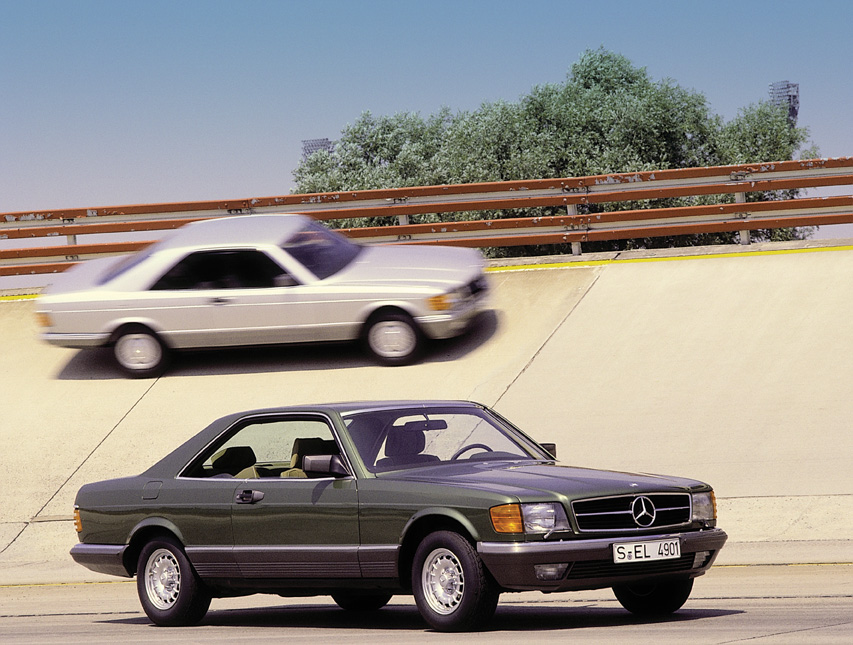 1979–1991 W126 Luxury Coupes
1979–1991 W126 Luxury Coupes
These beauties from Sindelfingen are safe, luxurious and wonderful value
Article Richard Simonds
Photography Daimler Archives
The officially designated S-Class began with the 1973-1980 W116 series of vehicles and continued with the W123 models. It can be argued that the S-Class series truly developed into a serious competitor for the hearts and minds of drivers who were safety-conscious and interested in a long-term investment with the W126 series of sedans and coupes. In addition, the amenities that North American drivers were beginning to expect in a luxury vehicle were quite well developed in the W126 series. Finally, legislation was mandating emissions controls, fuel economy, and safety bumpers. Climate-control a/c was becoming mandatory in the luxury-vehicle world. In terms of safety, Mercedes-Benz improved crumple zones, introduced ABS brakes, airbags, and safety belts (Supplemental Restraint Systems that held the driver in place in case of a collision).
The long-term investment in your Mercedes-Benz was assured by substantially improved rust-protection and better-developed engines with the beginnings of electronic controls and stricter tolerances. Aerodynamics reduced noise on the highway and contributed to better fuel economy. The first seat-shaped switches to adjust the seats (initially hydraulically controlled) appeared at this time and the intuitive design continues in current models 34 years later. Traction-control systems were introduced, as was a 4Matic system for owners seeking “go-anywhere” capability.
The luxury sedans (V-8 gasoline and 5-cylinder diesel) were covered in the January-February 2012 issue of The Star, “W126 Luxury Sedans Buyers Guide,” pages 56-59. Building on that article, we are looking at one 6-cylinder diesel engine sedan and three W126 coupes with 8-cylinder gasoline engines that were not included. Note that W126s were not available in the United States until 1981 and the 1979-1985 280S, 280SE, 280SEL models and pre-1984 500SEC models available in Europe only are not included in this Buyers Guide because no values are known for them. They were gray-market cars if imported to this country.
Reasons to Buy
- Safety, reliability, and comfort made them excellent for daily driving or long-trip touring
- Heating and a/c systems were becoming well-developed and usable year around
- Gasoline and diesel engines and drivetrains were increasingly robust for longevity
- Interiors (especially MB-Tex vinyl) are long-wearing and easy to clean
- Values are exceptional at this point in their lifecycle (22-34 years old) but are expected to begin appreciating for well-cared-for, preservation-class vehicles
- Diesels get mileage comparable to new Mercedes-Benz diesels (high 20s to low 30s on the road)
- The W126 design is still contemporary looking and offers comfort for passengers, plenty of trunk room for touring (or golf), and excellent visibility
Reasons not to Buy
- Any vehicle that has been driven into the ground by owners who believed that “bullet-proof” meant that no maintenance was required; these can be found at many websites
- Genuine M-B, OEM parts and service are relatively expensive (leading to the point, above)
- Aluminum block engines may need attention due to poor or postponed coolant replacement, head gasket leaks, oil leaks, or valve guides needing replacement (especially high-mileage examples)
- Even though the fuel crisis of 1973 was still fresh in mind, Daimler-Benz didn’t have gasoline models that were known for being thrifty in terms of miles-per-gallon
- Despite excellent rust protection, always check under fenders, door sills, rocker panels, floor pans, the sheet metal at the base of the rear windshield, and trunk sheet metal for rust – too easily camouflaged by fresh undercoating and paint
Checkpoints
- Watch for seats that sag – signs of broken springs, worn horsehair pads, and torn leather or MB-Tex
- Cracked dashboards or cracked vinyl/leather and wood trim
- Climate control systems should blow cold air from the center vents and the defroster vents should be completely closed to indicate that a/c actuators don’t need replacement
- Front suspension ball joints and bushings wear or failure
- Oil consumption should be checked (valve guides, head gaskets, and worn-out engines)
- Do NOT buy a 350SD/SDL without full ownership maintenance records unless you know the engine has been replaced
- Air conditioning compressors should be checked for replacement and, if necessary, replaced with a new Behr unit
- Avoid bio-diesel or vegetable oil conversions because the lubricity and cetane-ratings of these fuels can lead to engine failure and the need for a completely new engine
- The rear windshield can delaminate, leading to rust in its lower sheet metal panel
- The back door windows have a sliding-jaw gear that can render the windows inoperable; it is not an expensive part, but it can be expensive to replace
- Plastic radiators should be checked for leakage and cracking
- Airbags are supposed to be replaced every 10 years on ALL cars; check if this was done by an authorized Mercedes-Benz Center to maintain maximum safety for everyone in your vehicle
The Nitty-Gritty
Let’s start with the 350SDL sedan. The engine’s condition is the primary concern. Weak points were: 1) The connecting rods were not strong enough to handle the torque of the 6-cylinder engine; 2) if that didn’t cause a problem, then the connecting rods could be damaged by oil leaking past worn valve guides and fluid pressure on top of the piston would literally bend the rods; 3) poor fuel quality could contribute to engine damage; 4) lack of regular maintenance by inattentive owners led to engine failure; 5) stop-and-go traffic led to additional engine failures. Before you buy any 350SDL sedan, be certain that it has received an updated factory engine that resolved the many issues causing failures. If the answer is “yes” and the overall condition is good, you probably can enjoy a 350SDL for many years.
On the SECs, there are a few items to always check. First, radios were not always the best quality and may have been replaced by non-original radios. If you plan to enter concours des elegance, then this is a possible issue. Second, air-conditioning compressors and climate control valves may need to be replaced, and the Freon-based systems are difficult to maintain. Third, power windows are subject to failure due to weak gears and lack of periodic lubrication. Be sure that the 380SEC engine has had the single-row timing chain and gears replaced with a double-row assembly. As a less desirable alternative, be sure that the single-row timing chain and gears have been replaced every 100,000 miles, or more often if they have not been updated to a double-row assembly.
Finally, check that the plastic radiator has been replaced if it was leaking or cracked. And be sure that the engine does not consume excessive oil (no more than one quart every 1,500 miles) or be prepared to buy a rebuilt engine.
Value Guidelines
| Model | Year | Low | Medium | High |
|---|---|---|---|---|
| 350SDL | 1990–1991 | $3,600 | $6,200 | $8,900 |
| 380SEC | 1982–1984 | $5,500 | $14,400 | $19,700 |
| 500 SEC | 1984–1985 | $5,600 | $9,100 | $13,800 |
| 560 SEC | 1986–1991 | $5,600 | $9,200 | $14,400 |
Technical Specification
| Model | Engine | Sold in U.S. | Production | Engine | Type | Power/Torque | MPG | 0-60 |
|---|---|---|---|---|---|---|---|---|
| 350SDL | OM603 | 1990–1991 | 2,925 | 3.5L | I-6 TD | 134hp/228 lb-ft | 20-25 | 11.4 sec |
| 380SEC | M116 | 1982–1984 | 11,267 | 3.8L | V-8 gas | 155hp/196 lb-ft | 16-19 | 10.5 sec |
| 500SEC | M117 | 1984–1985 | 30,184 | 5.0L | V-8 gas | 185hp/247 lb-ft | 14-18 | 9.0 sec |
| 560SEC | M117 | 1986–1991 | 28,929 | 5.6L | V-8 gas | 238hp/287 lb-ft | 13-17 | 7.4 sec |
| Chronology | |
|---|---|
| 1979 | First W126 (280S, 280SE, 380SE & 500SE) delivered in Europe |
| 1980 | 280SEL, 380SEL, & 500SEL deliveries begin in Europe |
| 1981 | 380SEL & 500SEL introduced in the U.S. |
| 1982 | 380SEC & 500SEC are introduced; the 500SEC in Europe only |
| 1984 | 380SEL discontinued in the U.S. and replaced by 500SEL & 380SE; the 380SEC is also discontinued after two years |
| 1985 | Anti-lock brakes (ABS) become standard across the range |
| 1986 | 300SDL replaces 300SD; 560SEL and 420SEL replace previous models; 560SEC introduced in U.S.; airbags and K-Jetronic fuel injection now standard |
| 1988 | 300SE & 300SEL replace the 300SDL in U.S. |
| 1990 | 300SDL introduced in U.S. |
| 1991 | Mercedes-Benz replaces the W126 series with the W140 series |
Opposite page, top: W126 500SEC S-Class Coupes being tested on Daimler-Benz track in Untertürkheim in Germany. Note the sportier alloy wheels which were available as options to the more formal flat wheels.
